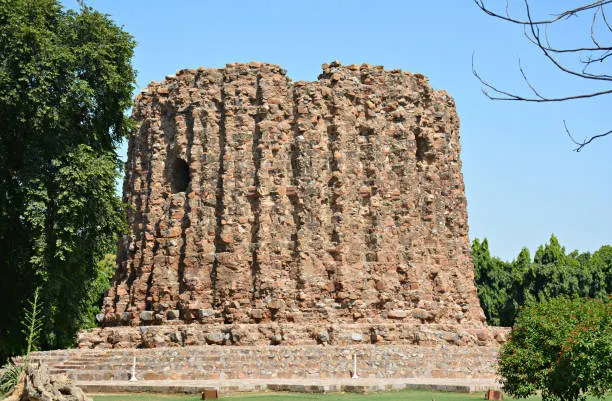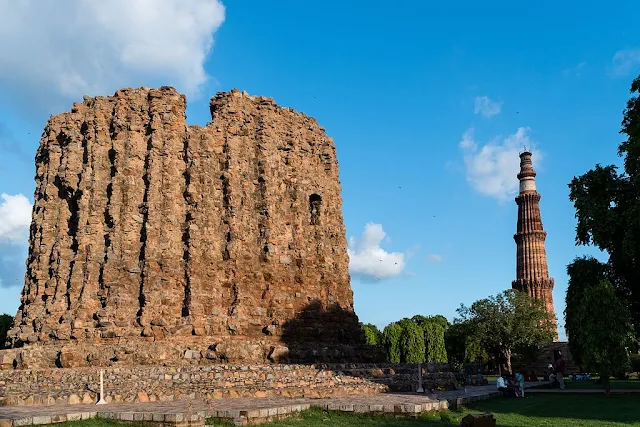Alai Minar, the Incomplete Minar
'The stone-carvers of Hind, who surpass even Farhad (a famous sculptor in Persian literature) in the art of stone carving, smoothed the stones so artistically that if our fancy passed over them it would slip down. The masons of Delhi, who consider Numan Muzir (the king of Hira in Mesopotamia and a master builder of castles, including the awe-inspiring Khawarnak) as nothing more than a mere stone in designing a building, making out their tools joined together one stone with another in such a manner that there was no danger of any secret crevice or cavity remaining between them...' (Amir Khusru)
Ala-ud-din Khilji (r: 1296-1316) was an ambitious ruler who held the title of the second Alexander (Sikandar-i-Sani). During his reign, he undertook extensive renovations of the Quwwat-ul-Islam mosque, also known as the Qutb mosque, in Delhi in 1311.
When Ala-ud-din extended the mosque and had the Alai Darwaza constructed, he aspired to erect a new minar in the mosque's courtyard, intending it to be twice the size of the renowned Qutb Minar.
Amir Khusru describes the noble ambition of the Sultan, who was determined to construct a magnificent structure that would rival the world-renowned Minar-i-Jami (Qutb Minar). The Sultan's vision was to create a minaret that would reach the heavens, symbolizing his grand aspirations. To achieve this, he first ordered the courtyard of the mosque to be extended as much as possible. Additionally, he commanded that the circumference of the new minaret be twice as large as the original, ensuring its proportional height and creating the illusion of the old minaret as a cupola at the center of the new one.
Stones were brought from far and near, from quarries and demolished temples. And so, the construction of this remarkable structure began.
Unfortunately, Sultan Ala-ud-din passed away in 1316, leaving the monumental minaret unfinished. Even the first floor remained incomplete at the time of his death. Ala-ud-din's son and successor, Qutb-ud-din Mubarak, showed no interest in finishing this magnificent structure.
The renowned Moroccan traveler Ibn Battuta marvels at the minaret's thickness and the breadth of its staircase, describing it as one of the wonders of the world. The staircase is so wide that three elephants could ascend it side by side. The staircase is so wide that three elephants at once can mount it side by side. This one-third portion of the minaret matched the height of the entire minaret in the northern courtyard (ie, the Qutb Minar).
According to Battuta, Sultan Muhammad Bin Tughlaq (r: 1325-1351) expressed a desire to complete the minaret. However, he ultimately changed his mind, considering its construction to be an ill omen.
The core of this incomplete Minar still stands tall at a height of approximately eighty feet as a silent witness, saddened by the loss of its patron Ala-ud-din Khilji.
Reference:
Tarikh-i-Alai or Khazain-ul-Fatuh (The Treasures of Victory) of Amir Khusru
Ala-ud-din Khilji (r: 1296-1316) was an ambitious ruler who held the title of the second Alexander (Sikandar-i-Sani). During his reign, he undertook extensive renovations of the Quwwat-ul-Islam mosque, also known as the Qutb mosque, in Delhi in 1311.
When Ala-ud-din extended the mosque and had the Alai Darwaza constructed, he aspired to erect a new minar in the mosque's courtyard, intending it to be twice the size of the renowned Qutb Minar.
Amir Khusru describes the noble ambition of the Sultan, who was determined to construct a magnificent structure that would rival the world-renowned Minar-i-Jami (Qutb Minar). The Sultan's vision was to create a minaret that would reach the heavens, symbolizing his grand aspirations. To achieve this, he first ordered the courtyard of the mosque to be extended as much as possible. Additionally, he commanded that the circumference of the new minaret be twice as large as the original, ensuring its proportional height and creating the illusion of the old minaret as a cupola at the center of the new one.
Stones were brought from far and near, from quarries and demolished temples. And so, the construction of this remarkable structure began.
Unfortunately, Sultan Ala-ud-din passed away in 1316, leaving the monumental minaret unfinished. Even the first floor remained incomplete at the time of his death. Ala-ud-din's son and successor, Qutb-ud-din Mubarak, showed no interest in finishing this magnificent structure.
The renowned Moroccan traveler Ibn Battuta marvels at the minaret's thickness and the breadth of its staircase, describing it as one of the wonders of the world. The staircase is so wide that three elephants could ascend it side by side. The staircase is so wide that three elephants at once can mount it side by side. This one-third portion of the minaret matched the height of the entire minaret in the northern courtyard (ie, the Qutb Minar).
According to Battuta, Sultan Muhammad Bin Tughlaq (r: 1325-1351) expressed a desire to complete the minaret. However, he ultimately changed his mind, considering its construction to be an ill omen.
The core of this incomplete Minar still stands tall at a height of approximately eighty feet as a silent witness, saddened by the loss of its patron Ala-ud-din Khilji.
Reference:
Tarikh-i-Alai or Khazain-ul-Fatuh (The Treasures of Victory) of Amir Khusru



Comments